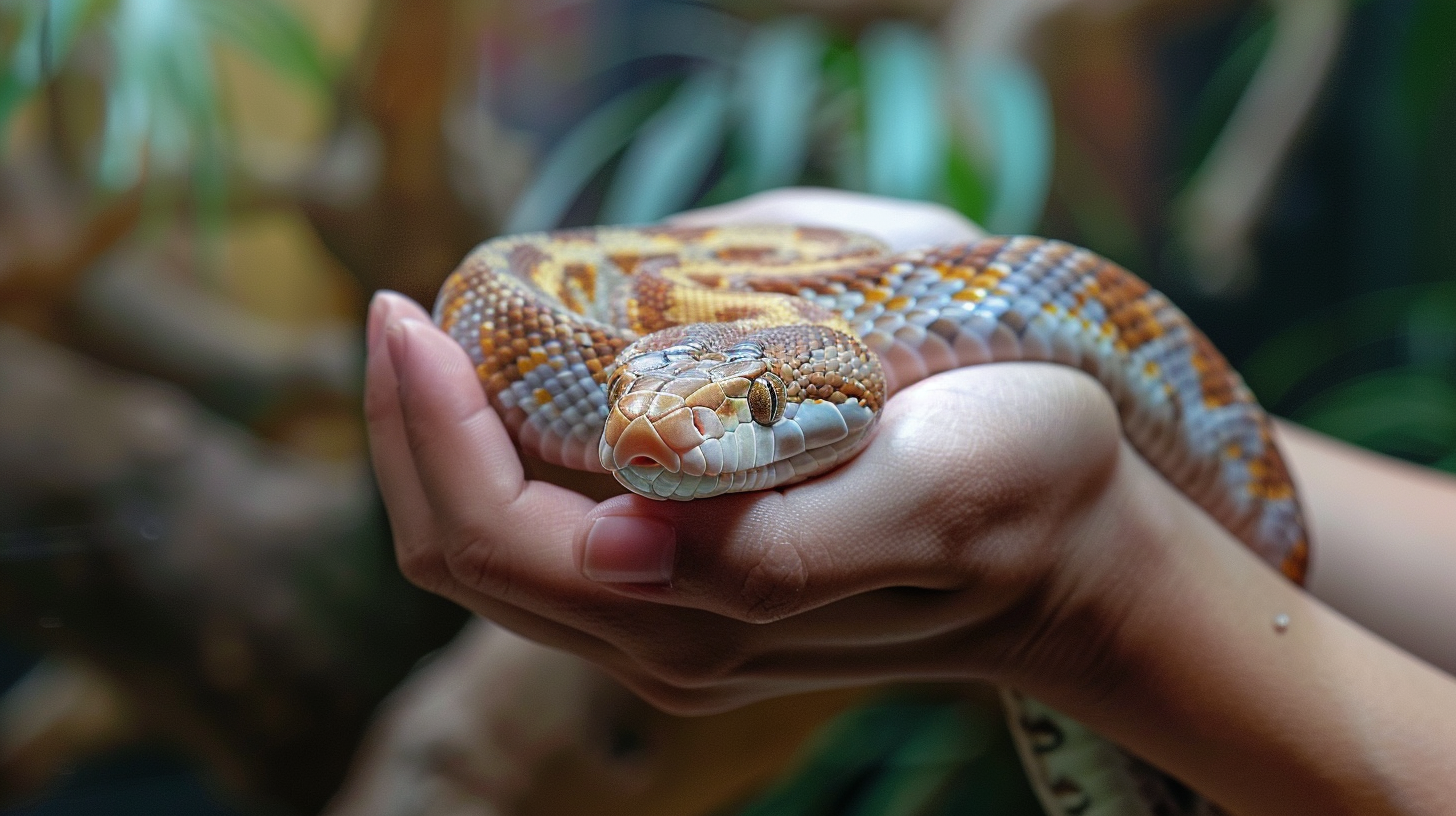Learn how to tame a snake safely with our expert 6-step guide. Discover proven techniques for building trust with your pet snake and creating lasting bonds.
Table of Contents
Owning a snake can be one of the most rewarding experiences in the reptile world, but many new snake owners wonder: how to tame a snake effectively and safely? Whether you’ve just brought home your first ball python, corn snake, or king snake, the process of building trust and establishing a bond with your serpentine companion requires patience, knowledge, and the right approach.
Snake taming isn’t about dominance or control—it’s about creating a relationship built on mutual respect and understanding. Unlike traditional pets, snakes communicate through body language and behavioral cues that many owners initially struggle to interpret. According to the American Veterinary Medical Association, proper handling and socialization techniques can significantly reduce stress-related health issues in captive reptiles, making taming not just beneficial for bonding but essential for your snake’s overall wellbeing.
In this comprehensive guide, we’ll walk you through six proven steps that will help you successfully tame your snake while ensuring both your safety and your pet’s comfort. From understanding snake behavior to mastering proper handling techniques, you’ll learn everything needed to transform your potentially defensive snake into a calm, handleable companion.
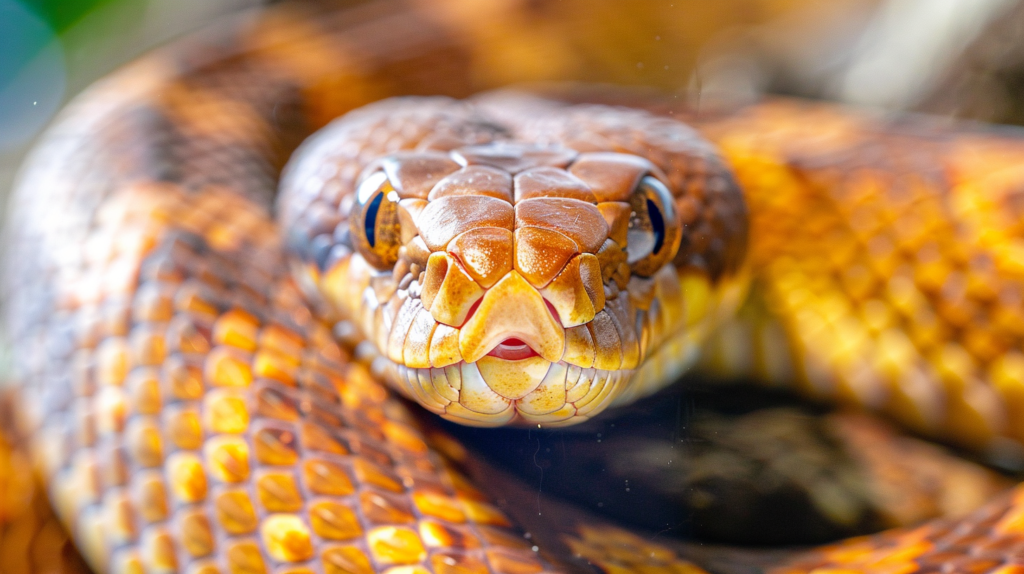
Understanding Snake Psychology Before You Begin
Before diving into the practical steps of how to tame a snake, it’s crucial to understand what makes these fascinating creatures tick. Snakes are fundamentally different from mammals in their psychological makeup and responses to human interaction.
The Snake’s Natural Instincts
Wild snakes have three primary responses to perceived threats: freeze, flee, or fight. When you first bring a snake home, it views you as a potential predator. This instinctual response is hardwired into their survival mechanisms and has nothing to do with aggression or meanness. Understanding this fundamental difference helps set realistic expectations for the taming process.
Dr. Sarah Mitchell, a herpetologist at the National Reptile Research Center, explains: “Snakes don’t experience emotions like affection in the way mammals do, but they can learn to associate humans with positive experiences and safety. This learned behavior is the foundation of what we call ‘taming.'”
Species-Specific Considerations
Different snake species have varying temperaments and taming requirements:
- Ball Pythons: Generally docile but prone to stress-induced feeding strikes
- Corn Snakes: Often naturally curious and easier to handle
- King Snakes: Can be more defensive initially but respond well to consistent handling
- Boa Constrictors: Require more respect due to size but can become very docile

Step 1: Create the Perfect Environment for Trust Building
The foundation of successful snake taming begins with providing an environment where your snake feels secure and comfortable. A stressed snake will never learn to trust you, making proper habitat setup your first priority.
Essential Habitat Requirements
Your snake’s enclosure should meet these minimum standards:
Temperature and Humidity Control:
- Establish a proper temperature gradient with a basking spot and cool side
- Maintain species-appropriate humidity levels (typically 50-60% for most species)
- Use reliable thermometers and hygrometers to monitor conditions consistently
Security and Hiding Places:
- Provide at least two hiding spots: one on the warm side and one on the cool side
- Ensure hiding spots are appropriately sized—snakes should feel snug but not cramped
- Use opaque materials for hiding spots to create genuine security
Substrate and Furnishing:
- Choose appropriate substrate that allows for natural behaviors
- Add branches or decorations for semi-arboreal species
- Ensure all furnishings are secure and won’t shift during movement
The Quarantine Period
New snakes should undergo a quarantine period of 4-8 weeks before beginning taming efforts. During this time:
- Monitor for signs of illness or parasites
- Allow the snake to establish feeding routines
- Minimize handling to reduce stress
- Observe natural behavior patterns
Important Statistics: Research from the Journal of Herpetological Medicine shows that snakes acclimated in proper environments for at least 30 days before handling attempts showed 73% less defensive behavior compared to those handled immediately upon arrival.
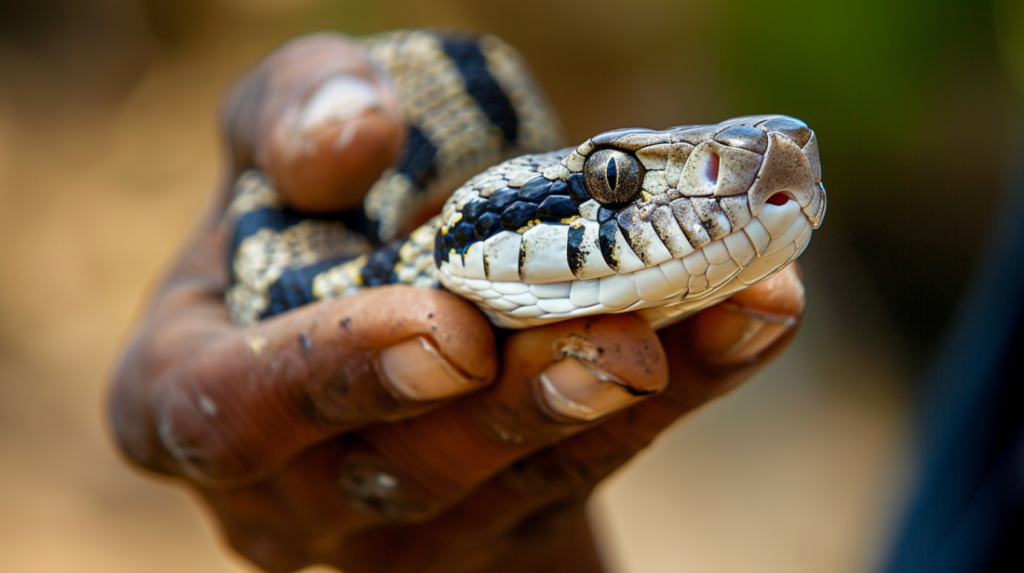
Step 2: Master the Art of Proper Timing
Timing is everything when learning how to tame a snake successfully. Approaching your snake at the wrong time can set back your progress significantly and potentially result in defensive behaviors that become harder to overcome.
Reading Your Snake’s Body Language
Before any handling attempt, observe your snake’s current state:
Signs Your Snake is Ready for Interaction:
- Relaxed posture with loose coils
- Normal breathing pattern (no rapid breathing)
- Alert but not defensive positioning
- Clear eyes (not in shed cycle)
Warning Signs to Avoid Handling:
- S-shaped defensive posture
- Rapid tongue flicking
- Hissing or aggressive striking motions
- Recently fed (wait 48-72 hours after feeding)
- In shed cycle (eyes appear milky or skin looks dull)
Optimal Handling Times
The best times to work with your snake include:
- Mid-morning when snakes are typically more alert but calm
- Late afternoon before their evening activity period
- Any time when the snake appears relaxed and comfortable
Never attempt handling when:
- Your snake has eaten within 48 hours
- During shedding periods
- When the snake displays defensive behaviors
- During breeding season (if applicable)
Building a Routine
Consistency in timing helps your snake predict and prepare for interactions, reducing stress over time. Establish regular handling sessions at similar times of day, starting with very brief encounters and gradually increasing duration as trust builds.
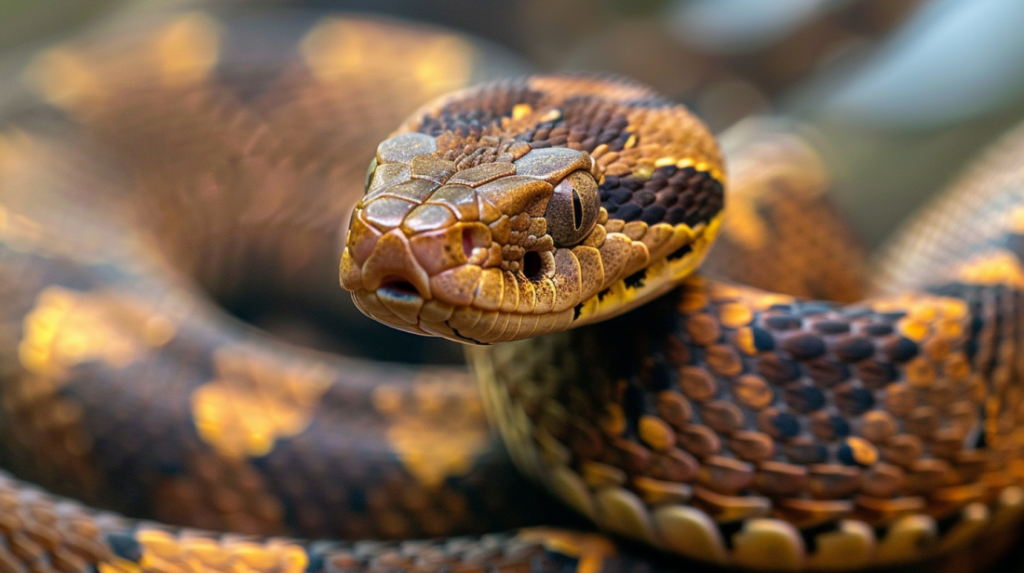
Step 3: Use Progressive Desensitization Techniques
Progressive desensitization is the cornerstone of how to tame a snake effectively. This technique involves gradually exposing your snake to human presence and touch in a controlled, non-threatening manner.
Phase 1: Presence Desensitization (Week 1-2)
Start by simply being near your snake’s enclosure:
- Sit quietly near the enclosure for 10-15 minutes daily
- Speak in soft, calm tones to familiarize your snake with your voice
- Move slowly and deliberately around the enclosure
- Feed your snake while present to create positive associations
Phase 2: Visual Contact and Tool Introduction (Week 2-3)
Once your snake shows comfort with your presence:
- Use a snake hook or tube for initial contact
- Gently touch the snake’s mid-body (never the head initially)
- Allow the snake to investigate the tool
- Reward calm behavior by immediately stopping contact
Phase 3: Hand Introduction (Week 3-4)
When your snake accepts tool contact:
- Wash hands thoroughly to remove any scents
- Approach from the side, never from above
- Start with brief, gentle touches on the snake’s mid-body
- Let the snake smell your hand before contact
Expert Tip: Herpetologist Dr. Robert Chen recommends the “confidence touch” technique: “Your snake can sense hesitation through your touch. Confident, gentle contact communicates safety, while nervous, quick movements trigger defensive responses.”
Tracking Progress
Keep a simple log of your snake’s responses:
| Week | Activity | Snake’s Response | Duration | Notes |
| 1 | Presence near tank | Hid initially, then curious | 10 min | Good progress |
| 2 | Hook contact | Slight recoil, then calm | 5 min | Accepting touch |
| 3 | Hand contact | No defensive posture | 3 min | Ready for lifting |
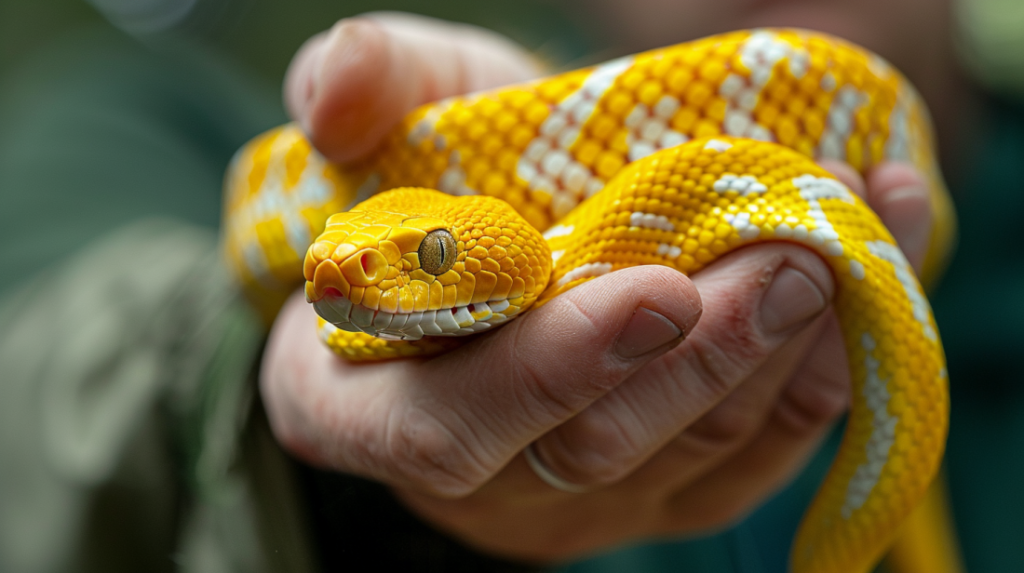
Step 4: Perfect Your Handling Technique
Proper handling technique is crucial for both safety and trust-building. Poor handling can undo weeks of progress and potentially harm both you and your snake.
The Correct Way to Pick Up Your Snake
Approach Method:
- Move slowly and confidently toward your snake
- Support the snake’s body weight at two points minimum
- Lift gently and smoothly without jerking motions
- Never grab just the head or tail
For Smaller Snakes (under 4 feet):
- Use both hands to support the body
- One hand near the head (about 1/3 down the body)
- Second hand supporting the rear portion
For Larger Snakes (over 4 feet):
- Use three or more contact points
- Never handle large snakes alone
- Support significant portions of the body weight
- Move deliberately and maintain control
Common Handling Mistakes to Avoid
Critical Errors That Damage Trust:
- Grabbing the snake suddenly or from above
- Supporting only the head or tail regions
- Handling immediately after feeding
- Forcing interaction when the snake shows stress signals
- Using excessive pressure or restraint
Building Handling Duration
Start with very brief handling sessions and gradually increase:
- Week 1: 30 seconds to 1 minute
- Week 2: 2-3 minutes
- Week 3: 5-7 minutes
- Week 4+: 10-15 minutes maximum per session
Important Safety Note: According to the Association of Reptilian and Amphibian Veterinarians, handling sessions should never exceed 15 minutes for most species, as extended handling can cause significant stress and health issues.
Creating Positive Handling Experiences
Make each handling session as pleasant as possible:
- Handle in a quiet, calm environment
- Avoid sudden movements or loud noises
- Allow the snake to move naturally in your hands
- End sessions on a positive note before the snake shows stress
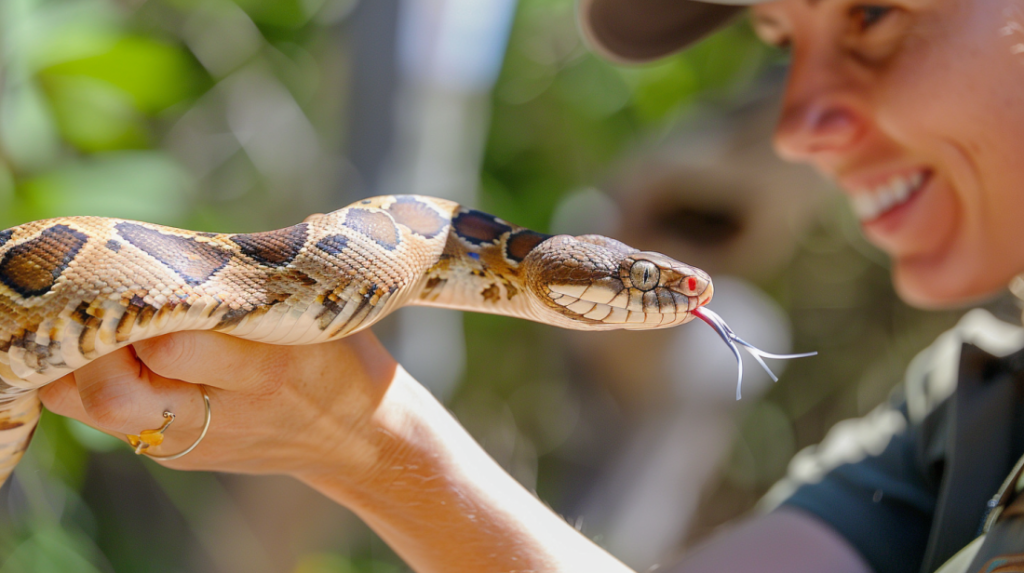
Step 5: Address and Overcome Common Behavioral Challenges
Even with perfect technique, you’ll likely encounter behavioral challenges when learning how to tame a snake. Understanding how to address these issues properly can make the difference between success and setback.
Dealing with Defensive Behaviors
Hissing and Striking: Hissing is your snake’s way of saying “I’m uncomfortable.” When this occurs:
- Stop all movement and remain calm
- Do not retreat suddenly (this reinforces the behavior)
- Wait for the snake to calm down before slowly backing away
- Evaluate what triggered the response and adjust your approach
Ball Python “Balling Up”: Ball pythons often curl into tight balls when stressed:
- Never try to force them to uncurl
- Place the snake in a secure, dark container
- Allow 10-15 minutes for natural relaxation
- Address the underlying stress cause
Overcoming Feeding-Related Aggression
Some snakes develop strong feeding responses that can interfere with handling:
Prevention Strategies:
- Use feeding tongs to maintain distance during feeding
- Feed in a separate container if possible
- Establish clear feeding schedules
- Never handle for 48-72 hours after feeding
Redirect Feeding Response: If your snake mistakes you for food:
- Present a snake hook first to redirect attention
- Use alcohol-based hand sanitizer to mask scents
- Feed more frequently to reduce food drive
Managing Species-Specific Challenges
Corn Snake Musking: Corn snakes may release a foul-smelling musk when stressed:
- This is normal defensive behavior
- Clean hands thoroughly after contact
- Reduce handling frequency temporarily
- Focus on environment improvements
King Snake Aggression: King snakes can be more defensive initially:
- Use thicker gloves if necessary during initial stages
- Employ longer tools for early contact
- Be extra patient with trust-building phases
- Never punish defensive behavior
When to Seek Professional Help
Contact a reptile veterinarian or experienced herpetologist if:
- Defensive behaviors increase rather than decrease over time
- Your snake stops eating for extended periods
- Physical symptoms of stress appear
- You feel unsafe during handling attempts
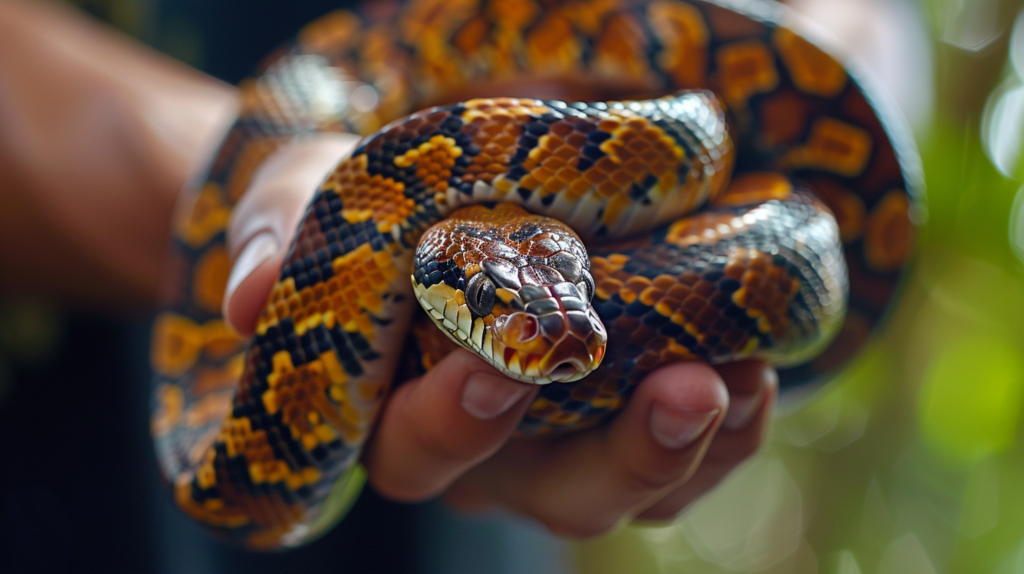
Step 6: Maintain Long-Term Success and Bonding
Successfully taming your snake is just the beginning. Maintaining the trust you’ve built requires ongoing attention to your snake’s needs and consistent handling practices.
Establishing a Maintenance Routine
Once your snake is comfortable with handling, establish a routine that keeps them socialized:
Weekly Handling Schedule:
- 2-3 handling sessions per week
- 10-15 minutes per session maximum
- Consistent timing when possible
- Regular health checks during handling
Monthly Assessment:
- Evaluate your snake’s comfort level
- Adjust handling frequency based on response
- Check for any developing behavioral issues
- Monitor overall health and body condition
Advanced Bonding Techniques
Environmental Enrichment:
- Rotate hiding spots and decorations occasionally
- Provide climbing opportunities for appropriate species
- Use different textures for sensory stimulation
- Create seasonal environmental variations
Trust-Building Exercises:
- Allow supervised exploration outside the enclosure
- Practice gentle examination of the snake’s body
- Introduce new (safe) scents and textures gradually
- Maintain consistent, calm energy during interactions
Recognizing and Maintaining Optimal Taming Results
Signs of a Well-Tamed Snake:
- Calm demeanor during handling
- Natural movement without excessive tension
- Curiosity about surroundings when held
- Normal feeding and elimination schedules
- Minimal defensive behaviors
Long-Term Success Indicators: According to a study published in Applied Animal Behavior Science, well-socialized snakes demonstrate:
- 85% reduction in stress-related behaviors
- Improved feeding responses
- Better overall health metrics
- Increased exploratory behaviors
Troubleshooting Regression
Sometimes previously tame snakes may regress:
Common Causes:
- Environmental changes or stressors
- Health issues or injury
- Breeding season hormonal changes
- Inconsistent handling routines
Recovery Strategies:
- Return to basic trust-building exercises
- Evaluate and address environmental factors
- Consult with veterinarian if health concerns exist
- Be patient and persistent with gentle handling
Safety Considerations and Best Practices
Safety should always be your top priority when learning how to tame a snake. Even non-venomous snakes can cause injury if handled improperly.
Essential Safety Equipment
Basic Safety Gear:
- Snake hooks of appropriate length for your species
- Thick gloves for initial handling (gradually transition away)
- Secure containers for transportation
- First aid supplies
Species-Specific Equipment:
- Tube restraints for defensive species
- Extra-long hooks for larger snakes
- Multiple handlers for giant species
- Emergency contact information for local reptile veterinarians
Bite Prevention and Response
Preventing Bites:
- Never handle during high-stress periods
- Use proper approach techniques
- Maintain awareness of snake’s mood
- Have escape routes planned
If Bitten by a Non-Venomous Snake:
- Remain calm and don’t jerk away suddenly
- Allow the snake to release naturally
- Clean wounds thoroughly with antiseptic
- Seek medical attention for deep punctures
- Monitor for signs of infection
Child and Pet Safety
Guidelines for Households with Children:
- Always supervise interactions between children and snakes
- Teach proper handling techniques before allowing independent handling
- Establish clear rules about when snakes should not be disturbed
- Ensure children understand snake behavior basics
Multi-Pet Households:
- Keep snakes completely separated from other pets
- Be aware of scent transfer between animals
- Never allow dogs or cats near snake handling areas
- Store snake securely when not being supervised
Visual Guide: Step-by-Step Handling Process
The visual representation above demonstrates the proper progression from initial approach to confident handling. Each step builds upon the previous one, ensuring both safety and success in your snake taming journey.
Common Myths About Snake Taming Debunked
Myth 1: Snakes Can Be Trained Like Dogs
Reality: Snakes don’t learn tricks or respond to commands. They develop tolerance and comfort with handling through consistent, positive experiences.
Myth 2: All Snakes Eventually Become Aggressive
Reality: Properly cared for and handled snakes typically become more docile over time, not more aggressive.
Myth 3: You Must Establish Dominance Over Your Snake
Reality: Dominance concepts don’t apply to reptiles. Trust and comfort are built through positive associations, not dominance displays.
Myth 4: Feeding Live Prey Makes Snakes More Aggressive
Reality: While feeding responses can be strong, properly managed feeding routines don’t increase general aggression toward humans.
Myth 5: Some Snakes Are Impossible to Tame
Reality: While individual temperaments vary, virtually all commonly kept species can learn to tolerate handling with proper techniques and patience.
Frequently Asked Questions (FAQ)
Q: How long does it typically take to tame a snake completely?
A: The timeline varies significantly based on species, individual temperament, and consistency of handling. Most snakes show noticeable improvement within 4-6 weeks of consistent, proper handling. Full comfort and trust typically develop over 3-6 months. Some naturally defensive species may take up to a year to become completely comfortable with regular handling.
Q: Can older, wild-caught snakes be tamed successfully?
A: Yes, but the process is generally more challenging and time-consuming than with captive-bred snakes. Wild-caught snakes have stronger defensive instincts and may take 6-12 months or longer to become comfortable with handling. The same techniques apply, but patience and persistence are even more crucial for success.
Q: Is it normal for my snake to stop eating during the taming process?
A: Brief feeding strikes (1-2 missed meals) can occur due to the stress of new handling routines, but extended feeding refusal may indicate too much stress or handling pressure. If your snake refuses food for more than 3-4 weeks, reduce handling frequency and consult with a reptile veterinarian to rule out health issues.
Q: What should I do if my snake seems to get more defensive over time instead of calmer?
A: Increasing defensiveness usually indicates that something in your approach needs adjustment. Common causes include handling too frequently, poor timing (such as during shed cycles), or environmental stressors. Take a step back, reduce handling frequency, and carefully evaluate your techniques and timing. Sometimes returning to earlier steps in the taming process is necessary.
Q: Are there any snake species that should never be handled or tamed?
A: While most commonly kept pet snakes can be successfully tamed, some species are naturally more defensive and require extra caution. Highly defensive species like some water snakes or certain wild-type individuals may never become as comfortable with handling as docile species like ball pythons or corn snakes. However, even these snakes can usually learn to tolerate necessary handling for health checks and maintenance.
Q: How can I tell if I’m handling my snake too much during the taming process?
A: Signs of over-handling include: refusing food, excessive hiding, increased defensive behaviors, lethargy, or any signs of illness. Most snakes should not be handled more than 2-3 times per week for 10-15 minutes maximum. If you notice any stress indicators, reduce handling frequency and duration until your snake returns to normal behavior patterns.
For more expert pet care tips and product recommendations, visit BlithePet.com — your trusted source for pet wellness.
Conclusion
Learning how to tame a snake successfully requires patience, consistency, and respect for your reptile’s natural behaviors and needs. The six steps outlined in this guide—creating the right environment, mastering timing, using progressive desensitization, perfecting handling techniques, addressing challenges, and maintaining long-term success—provide a comprehensive framework for building trust with your snake companion.
Remember that every snake is an individual with unique personality traits and comfort levels. What works perfectly for one snake might need adjustment for another. The key to success lies in observing your snake’s responses, adapting your approach accordingly, and maintaining realistic expectations throughout the process.
Success in snake taming isn’t measured by how quickly you can handle your snake, but by how comfortable and stress-free the experience becomes for both of you. A well-tamed snake will not only be easier to care for but will also live a healthier, less stressful life in captivity.
By following these proven techniques and prioritizing safety above all else, you’ll be well on your way to developing a positive relationship with your serpentine companion that can last for many years to come.
Have a similar experience with your pet? Share it in the comments below!

